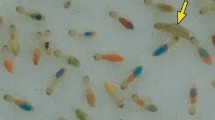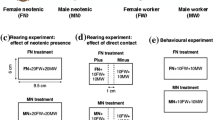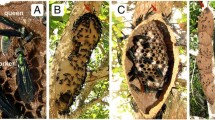Abstract
In social insects, the postembryonic development of individuals exhibits strong phenotypic plasticity in response to the environment, thus generating the caste system. Different from eusocial Hymenoptera, in which queens dominate reproduction and inhibit worker fertility, the primary reproductive caste in termites (kings and queens) can be replaced by neotenic reproductives derived from functionally sterile individuals. Feedback regulation of nestmate differentiation into reproductives has been suggested, but the sex specificity remains inconclusive. In the eastern subterranean termite, Reticulitermes flavipes, we tested the hypothesis that neotenic reproductives regulate worker-reproductive transition in a sex-specific manner. With this R. flavipes system, we demonstrate a sex-specific regulatory mechanism with both inhibitory and stimulatory functions. Neotenics inhibit workers of the same sex from differentiating into additional reproductives but stimulate workers of the opposite sex to undergo this transition. Furthermore, this process is not affected by the presence of soldiers. Our results highlight the reproductive plasticity of termites in response to social cues and provide insights into the regulation of reproductive division of labor in a hemimetabolous social insect.






Similar content being viewed by others
References
Ghesini S, Marini M (2009) Caste differentiation and growth of laboratory colonies of Reticulitermes urbis (Isoptera, Rhinotermitidae). Insect Soc 56:309–318
Grassé PP, Noirot C (1960) Role respectif des males et des femelles dans la formation des sexués néoténiques chez Calotermes flavicollis. Insect Soc 7:109–123
Hanus R, Vrkoslav V, Hrdý I, Cvačka J, Šobotník J (2010) Beyond cuticular hydrocarbons: evidence of proteinaceous secretion specific to termite kings and queens. Proc R Soc B 277:995–1002
Hartfelder K, Engels W (1998) Social insect polymorphism: hormonal regulation of plasticity in development and reproduction in the honeybee. In: Pedersen RA, Schatten GP (eds) Current topics in developmental biology. Academic Press, San Diego, pp 45–78
Haverty M, Howard R (1981) Production of soldiers and maintenance of soldier proportions by laboratory experimental groups of Reticulitermes flavipes (Kollar) and Reticulitermes virginicus (Banks) (Isoptera: Rhinotermitidae). Insect Soc 28:32–39
Howard RW, Haverty MI (1980) Reproductives in mature colonies of Reticulitermes flavipes: abundance, sex-ratio, and association with soldiers. Environ Entomol 9:458–460
Korb J, Hartfelder K (2008) Life history and development—a framework for understanding developmental plasticity in lower termites. Biol Rev 83:295–313
Korb J, Weil T, Hoffmann K, Foster KR, Rehli M (2009) A gene necessary for reproductive suppression in termites. Science 324:758–758
Kucharski R, Maleszka J, Foret S, Maleszka R (2008) Nutritional control of reproductive status in honeybees via DNA methylation. Science 319:1827–1830
Lainé LV, Wright DJ (2003) The life cycle of Reticulitermes spp. (Isoptera: Rhinotermitidae): what do we know? Bull Entomol Res 93:267–278
Le Conte Y, Hefetz A (2008) Primer pheromones in social Hymenoptera. Annu Rev Entomol 53:523–542
Liebig J, Eliyahu D, Brent C (2009) Cuticular hydrocarbon profiles indicate reproductive status in the termite Zootermopsis nevadensis. Behav Ecol Sociobiol 63:1799–1807
Long CE, Thorne BL, Breisch NL (2003) Termite colony ontogeny: a long-term assessment of reproductive lifespan, caste ratios and colony size in Reticulitermes flavipes (Isoptera: Rhinotermitidae). Bull Entomol Res 93:439–445
Lüscher M (1964) Die spezifische Wirkung männlicher und weiblicher Ersatzgeschlechtstiere auf die Entstehung von Ersatzgeschlechtstieren bei der Termite Kalotermes flavicollis (Fabr.) Insect Soc 11:79–90
Matsuura K, Himuro C, Yokoi T, Yamamoto Y, Vargo EL, Keller L (2010) Identification of a pheromone regulating caste differentiation in termites. Proc Natl Acad Sci U S A 107:12963–12968
Miyaguni Y, Sugio K, Tsuji K (2013) The unusual neotenic system of the Asian dry wood termite, Neotermes koshunensis (Isoptera: Kalotermitidae). Sociobiology 60:65–68
Miyata H, Furuichi H, Kitade O (2004) Patterns of neotenic differentiation in a subterranean termite, Reticulitermes speratus (Isoptera: Rhinotermitidae). Entomol Sci 7:309–314
Moore B (1974) Pheromones in the termite societies. In: Birch M (ed) Pheromones. North-Holland Publishing, Amsterdam, pp 250–266
Myles TG (1999) Review of secondary reproduction in termites (Insecta: Isoptera) with comments on its role in termite ecology and social evolution. Sociobiology 33:1–43
Noirot C (1990) Sexual castes and reproductive strategies in termites. In: Engels W (ed) Social insects. Springer, Berlin, pp 5–35
Page RE, Amdam GV (2007) The making of a social insect: developmental architectures of social design. BioEssays 29:334–343
Penick CA, Trobaugh B, Brent CS, Liebig J (2013) Head-butting as an early indicator of reproductive disinhibition in the termite Zootermopsis nevadensis. J Insect Behav 26:23–34
Pichon A, Kutnik M, Leniaud L, Darrouzet E, Chaline N, Dupont S, Bagnères A (2007) Development of experimentally orphaned termite worker colonies of two Reticulitermes species (Isoptera: Rhinotermitidae). Sociobiology 50:1015–1034
Roisin Y (2000) Diversity and evolution of caste patterns. In: Abe T, Bignell DE, Higashi M (eds) Termites: evolution, sociality, symbioses, ecology. Springer, Netherlands, pp 95–119
Roisin Y, Korb J (2011) Social organisation and the status of workers in termites. In: Bignell DE, Roisin Y, Lo N (eds) Biology of termites: a modern synthesis. Springer, Netherlands, pp 133–164
Su N-Y, Scheffrahn RH, Cabrera BJ (2001) Native subterranean termites: Reticulitermes flavipes (Kollar), Reticulitermes virginicus (Banks), Reticulitermes hageni Banks (Insecta: Isoptera: Rhinotermitidae). University of Florida Cooperative Extension Service, Institute of Food and Agricultural Sciences, EDIS, Gainesville
Tian L, Zhou X (2014) The soldiers in societies: defense, regulation, and evolution. Int J Biol Sci 10:296–308
Van Oystaeyen A, Oliveira RC, Holman L et al (2014) Conserved class of queen pheromones stops social insect workers from reproducing. Science 343:287–290
Watanabe D, Gotoh H, Miura T, Maekawa K (2014) Social interactions affecting caste development through physiological actions in termites. Front Physiol 5:127
Watson J, Abbey HM (1985) Development of neotenics in Mastotermes darwiniensis Froggatt: an alternative strategy. In: Watson JAL, Okot-Kotber BM, Noirot C (eds) Caste differentiation in social insects. Pergamon Press, Oxford, pp 107–124
Watson JAL, Metcalf EC, Sewell JJ (1975) Preliminary studies on the control of neotenic formation in Mastotermes darwiniensis Froggatt (Isoptera). Insect Soc 22:415–426
Zhou X, Oi FM, Scharf ME (2006) Social exploitation of hexamerin: RNAi reveals a major caste-regulatory factor in termites. Proc Natl Acad Sci U S A 103:4499–4504
Acknowledgments
We thank Dr. Li Tian (Pennsylvania State University) for his help with photography and members of the Zhou lab for their comments and discussion. This study was supported by William L. and Ruth D. Nutting Student Research Grant from the International Union for the Study of Social Insects (North American Section), Kentucky Opportunity Fellowship from the University of Kentucky to Q.S., and the US Department of Agriculture (USDA) National Institute of Food and Agriculture (NIFA) Hatch project (accession number 1004654) to X.Z. Any opinions, findings, conclusions, or recommendations expressed in this publication are those of the authors’ and do not necessarily reflect the view of NIFA or USDA. This is publication No. 17-08-002 of the Kentucky Agricultural Experiment Station and is published with the approval of the Director. The granting agencies have no role in the study design, data collection and analysis, decision to publish, or preparation of the manuscript.
Author information
Authors and Affiliations
Contributions
Q.S., K.F.H., and X.Z. designed the experiments; Q.S. and J.D.H conducted the experiments; Q.S. and K.F.H analyzed the data; Q.S. wrote the manuscript; and K.F.H and X.Z. revised the manuscript. All authors approved the final manuscript.
Corresponding author
Ethics declarations
Data availability
All data generated or analyzed during this study are included in this published article and its supplementary information files.
Additional information
Communicated by: Sven Thatje
Rights and permissions
About this article
Cite this article
Sun, Q., Haynes, K.F., Hampton, J.D. et al. Sex-specific inhibition and stimulation of worker-reproductive transition in a termite. Sci Nat 104, 79 (2017). https://doi.org/10.1007/s00114-017-1501-5
Received:
Revised:
Accepted:
Published:
DOI: https://doi.org/10.1007/s00114-017-1501-5




